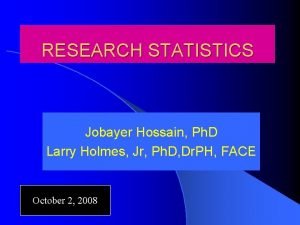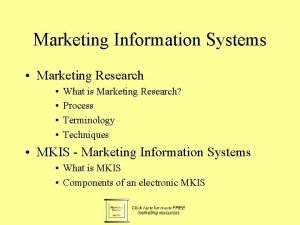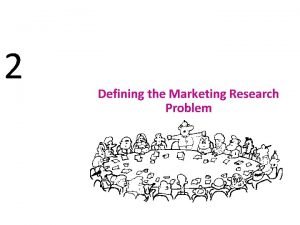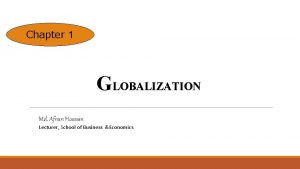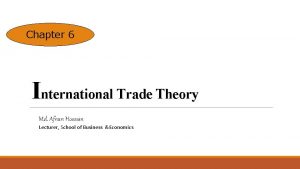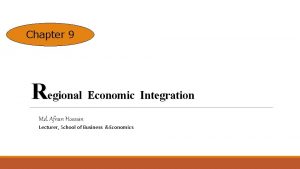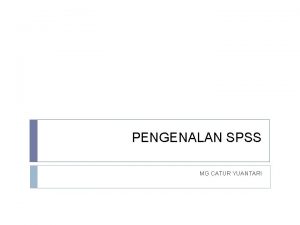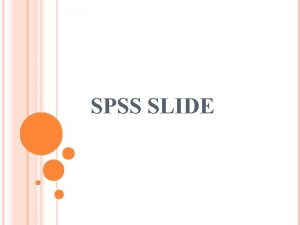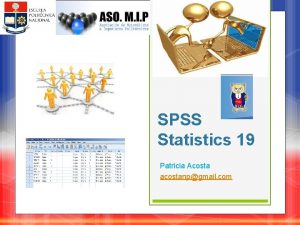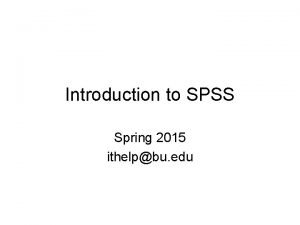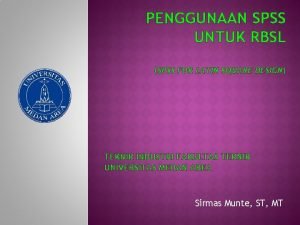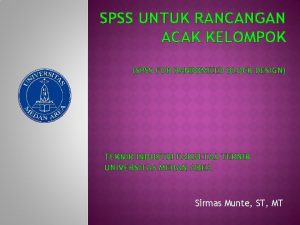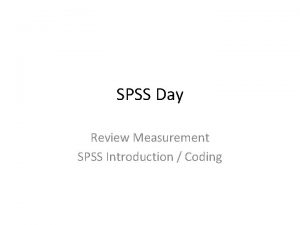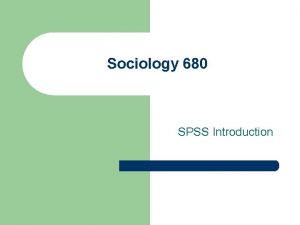marketing research with Spss Md Afnan Hossain Lecturer




































- Slides: 36

marketing research with Spss Md. Afnan Hossain Lecturer, School of Business & Economics

Variable View

Data View

Frequency

Frequency (cont. )

Frequency (cont. )

Frequency Output (cont. )

Frequency Output (cont. )

Cross-Tabulation

Cross-Tabulation (Cont. )

Cross-Tabulation Output (Cont. )

Two Hypotheses A null hypothesis is a claim (or statement) about a population parameter that is assumed to be true until it is declared false. An alternative hypothesis is a claim about a population parameter that will be true if the null hypothesis is false.

Two Types of Errors Example: Four Possible Outcomes for a Court Case

Two Types of Errors Definition A Type I error occurs when a true null hypothesis is rejected. The value of α represents the probability of committing this type of error; that is, α = P(H 0 is rejected | H 0 is true) The value of α represents the significance level of the test.

Two Types of Errors Definition A Type II error occurs when a false null hypotheses is not rejected. The value of β represents the probability of committing a Type II error; that is, β = P (H 0 is not rejected | H 0 is false) The value of 1 – β is called the power of the test. It represents the probability of not making a Type II error.

Tails of a Test Definition A two-tailed test has rejection regions in both tails, a left-tailed test has the rejection region in the left tail, and a right-tailed test has the rejection region in the right tail of the distribution curve.

Signs in H 0 and H 1 and Tails of a Test

A Two-Tailed Test • According to a survey by Consumer Reports magazine conducted in 2008, a sample of sixth graders selected from New York schools showed that their backpacks weighed an average of 18. 4 pounds (USA TODAY, August 3, 2009). Another magazine wants to check whether or not this mean has changed since that survey. The key word here is changed. • The mean weight of backpacks for sixth-graders in New York has changed if it has either increased or decreased since 2008. This is an example of a two tailed test.

A Two-Tailed Test • Let μ be the weight of backpacks for the current sixthgraders in New York. The two possible decisions are • H 0 : μ = 18. 4 pounds (The mean weight of backpacks for sixth-graders in New York has not changed) • H 1 : μ ≠ 18. 4 pounds (The mean weight of backpacks for sixth-graders in New York has changed)

A Left-Tailed Test Reconsider the example of the mean amount of soda in all softdrink cans produced by a company. The company claims that these cans, on average, contain 12 ounces of soda. However, if these cans contain less than the claimed amount of soda, then the company can be accused of cheating. Suppose a consumer agency wants to test whether the mean amount of soda per can is less than 12 ounces. Note that the key phrase this time is less than, which indicates a left-tailed test.

A Left-Tailed Test • Let μ be the mean amount of soda in all cans. The two possible decisions are • H 0 : μ = 12 ounces (The mean is equal to 12 ounces) • H 1 : μ < 12 ounces (The mean is less than 12 ounces)

A Right-Tailed Test According to www. city-data. com, the average price of homes in West Orange, New Jersey, was $461, 216 in 2007. Suppose a real estate researcher wants to check whether the current mean price of homes in this town is higher than $461, 216. The key phrase in this case is higher than, which indicates a right-tailed test.

A Right-Tailed Test • Let μ be the current mean price of homes in this town. The two possible decisions are • H 0 : μ = $461, 216 (The current mean price of homes in this town is not higher than $461, 216) • H 1 : μ > $461, 216 (The current mean price of homes in this town is higher than $461, 216)

Two Procedures Two procedures to make tests of hypothesis 1. The p-value approach 2. The critical-value approach

Hypothesis Test Assuming that the null hypothesis is true, the p-value can be defined as the probability that a sample statistic (such as the sample mean) is at least as far away from the hypothesized value in the direction of the alternative hypothesis as the one obtained from the sample data under consideration. Note that the p–value is the smallest significance level at which the null hypothesis is rejected.

Steps to Perform a Test of Hypothesis Using the p–Value Approach 1. State the null and alternative hypothesis. 2. Select the distribution to use. 3. Calculate the p–value. 4. Make a decision.

HYPOTHESIS TESTS ABOUT μ: σ KNOWN Three Possible Cases

Calculating the z Value for x When using the normal distribution, the value of z for x for a test of hypothesis about μ is computed as follows: The value of z calculated for x using this formula is also called the observed value of z.

HYPOTHESIS TESTS ABOUT μ: σ NOT KNOWN Three Possible Cases

HYPOTHESIS TESTS ABOUT μ: σ NOT KNOWN Test Statistic The value of the test statistic t for the sample mean x is computed as The value of t calculated for x by using this formula is also called the observed value of t.

t test - One Sample - Independent Samples - Paired Samples One Sample – In Marketing research, the researcher is often interested in making statements about a single variable against a known or given standard. Suppose we want to test the hypothesis that the mean “Satisfies my needs” rating exceeds 4. 0, the neutral value on a 7 -point scale. A significance level of α = 0. 05 is selected. The hypothesis may be formulated as: H 0 ≤ 4. 0 H 1 > 4. 0

One Sample t test – In Marketing research, the researcher is often interested in making statements about a single variable against a known or given standard. Suppose we want to test the hypothesis that the mean “Satisfies my needs” rating exceeds 4. 0, the neutral value on a 7 -point scale. A significance level of α = 0. 05 is selected. The hypothesis may be formulated as: H 0 ≤ 4. 0 H 1 > 4. 0 Test α= 0. 05, X = 5. 7, µ = 4, S = 1. 84, SX = 1. 84/√ 30 = 0. 33 t= (5. 7 -4)/0. 33 = 5. 15, df = n-1 = 30 -1 = 29 (sample size = 30) t= 5. 15 & df 29, P value is closer to. 000, as P<α, so reject H 0. H 1 is supported.


One Sample t test through SPSS


One Sample t test through SPSS
 Chapter 8 foreign direct investment
Chapter 8 foreign direct investment Lecturer's name or lecturer name
Lecturer's name or lecturer name Dr ali hossain
Dr ali hossain Where did pritilata fight
Where did pritilata fight Dr. afzal hossain
Dr. afzal hossain Abid hossain mollah
Abid hossain mollah Bellal hossain
Bellal hossain Bellal hossain
Bellal hossain Bellal hossain
Bellal hossain Md bellal hossain
Md bellal hossain Welcome to english class images
Welcome to english class images Jobayer hossain
Jobayer hossain Physician associate lecturer
Physician associate lecturer Spe distinguished lecturer
Spe distinguished lecturer Good afternoon, teacher
Good afternoon, teacher Photography lecturer
Photography lecturer Lecturer in charge
Lecturer in charge Designation lecturer
Designation lecturer Designation of lecturer
Designation of lecturer Guest lecturer in geography
Guest lecturer in geography Lecturer name
Lecturer name Pearson lecturer resources
Pearson lecturer resources 140000/120
140000/120 Lector vs lecturer
Lector vs lecturer Lecturer in charge
Lecturer in charge Cfa lecturer handbook
Cfa lecturer handbook Lecturer asad ali
Lecturer asad ali Finer segmentation strategy
Finer segmentation strategy Marketing information systems and marketing research
Marketing information systems and marketing research Define marketing information management
Define marketing information management Marketing information systems and marketing research
Marketing information systems and marketing research Marketing information systems and marketing research
Marketing information systems and marketing research Marketing information systems and marketing research
Marketing information systems and marketing research Problem definition in research
Problem definition in research The production concept holds that
The production concept holds that Digital marketing marketing refers
Digital marketing marketing refers Basic marketing a marketing strategy planning approach
Basic marketing a marketing strategy planning approach











